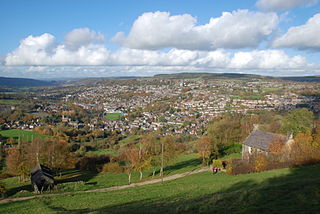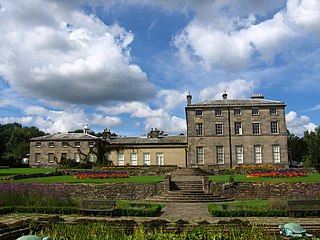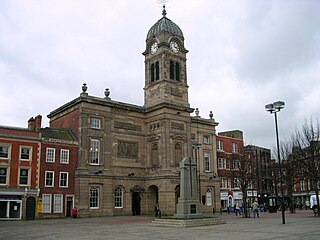
Derbyshire is a ceremonial and non-metropolitan county in the East Midlands, England. The county is the westernmost in the East Midlands. It covers much of the Peak District National Park, the southern end of the Pennine range of hills and part of the National Forest. It is bordered by Greater Manchester to the north-west, West Yorkshire to the north, South Yorkshire to the north-east, Nottinghamshire to the east, Leicestershire to the south-east, Staffordshire to the west and south-west, and Cheshire to the west. The county's largest settlement and only city, Derby, is now administered as a unitary authority. The rest of Derbyshire remains in the Derbyshire County Council local authority area.

Sir George Gilbert Scott, largely known as Sir Gilbert Scott, was a prolific English Gothic Revival architect, chiefly associated with the design, building and renovation of churches and cathedrals, although he started his career as a leading designer of workhouses. Over 800 buildings were designed or altered by him.

TheCathedral Church of All Saints Derby, better known as Derby Cathedral, is a cathedral church in the city of Derby, England. In 1927, it was promoted from parish church status, to a cathedral, creating a seat for the Bishop of Derby, which new see was created in that year. The original church of All Saints was founded in the mid-10th century as a royal collegiate church, dedicated to All Saints. The main body of the church as it stands today is a Georgian rebuilding by James Gibbs, completed in 1725. The tower dates from the 16th century, and a retroquire was added in the 20th century.

Matlock is the county town of Derbyshire, England. It is in the south-eastern part of the Peak District, with the National Park directly to the west. The town is twinned with the French town of Eaubonne. The former spa resort of Matlock Bath lies immediately south of the town on the A6. The civil parish of Matlock Town had a population in the 2011 UK census of 9,543.

Wirksworth is a market town in the Derbyshire Dales district of Derbyshire, England. Its population of 5,038 in the 2011 census was estimated at 5,180 in 2019. Wirksworth contains the source of the River Ecclesbourne. The town was granted a market charter by Edward I in 1306 and still holds a market on Tuesdays in the Memorial Gardens. The parish church of St Mary's is thought to date from 653. The town developed as a centre for lead mining and stone quarrying. Many lead mines were owned by the Gell family of nearby Hopton Hall.

The University of Derby, formerly known as Derby College, is a public university in the city of Derby, England. It traces its history back to the establishment of the Derby Diocesan Institution for the Training of Schoolmistresses in 1851. It gained university status in 1992.

Allestree is a suburb and ward of the city of Derby, a unitary authority area, in Derbyshire, England. It is the northernmost ward and is on the A6 road, about 2 miles (3 km) north of Derby city centre. It is bordered by the district of Amber Valley along its western and northern edges and Erewash in its north-east corner. To the south it borders the ward of Mackworth and to the east the ward of Darley Abbey.

The history of Derbyshire can be traced back to human settlement since the last Ice Age, over 10,000 years ago. The county of Derbyshire in England dates back to the 11th century.

Sir Arthur William Blomfield was an English architect. He became president of the Architectural Association in 1861; a Fellow of the Royal Institute of British Architects in 1867 and vice-president of the RIBA in 1886. He was educated at Trinity College, Cambridge, where he studied Architecture.

Joseph Pickford was an English architect, one of the leading provincial architects in the reign of George III. The house he designed for himself in Derby is now the Pickford's House Museum.

Alfreton Hall is a country house in Alfreton, Derbyshire. It was at the heart of local social and industrial history in the county. The history of the estate goes back to Norman times, but by the 17th century it was owned by the Morewood family, who were linked to local industry, mainly in coal mining.

Derby is a city and unitary authority area on the River Derwent in Derbyshire, England. It was historically the county town of Derbyshire; the county council moved to Matlock in 1956. The city's population was 261,400 in 2021.

Willersley Castle is a late 18th-century country mansion above the River Derwent at Cromford, Derbyshire, outside Peak District National Park. The castle has been a Grade II* listed building since April 2000.
Mendip is a local government district in the English county of Somerset. The Mendip district covers a largely rural area of 285 square miles (738 km2) ranging from the Mendip Hills through on to the Somerset Levels. It has a population of approximately 11,000. The administrative centre of the district is Shepton Mallet.

There are 19 Grade I listed buildings in the City of Coventry. In the United Kingdom, a listed building is a building or structure of special historical or architectural importance. These buildings are legally protected from demolition, as well as from any extensions or alterations that would adversely affect the building's character or destroy historic features. Listed buildings in England and Wales are divided into three categories—Grade II buildings are buildings of special interest; Grade II* buildings are Grade II buildings of particular interest; and Grade I buildings, which are those of "exceptional" interest. Only around four per cent of listed buildings are given Grade I status.

There are 48 Grade I listed buildings in Greater Manchester, England. In the United Kingdom, the term listed building refers to a building or other structure officially designated as being of special architectural, historical or cultural significance; Grade I structures are those considered to be "buildings of exceptional interest". In England, the authority for listing under the Planning Act 1990 rests with Historic England, a non-departmental public body sponsored by the Department for Culture, Media and Sport.

The Old Bell Hotel in Derby, Derbyshire, United Kingdom, is one of Derby's oldest and largest coaching inns. It was is built in 1650, in the historic street of Sadler Gate in the city's Cathedral Quarter. The hotel is a Grade II listed building and is included in the Derby City Statutory List of Buildings of Special Architecture or Historic Interest. Although much of the building has been altered and restored, most of the original structure can still be seen from the street, consisting of a timber-framed building of four storeys with four gables, each with one window, at the top. Over the years The Old Bell Hotel has served as a coaching inn, hotel, bar, restaurant, doctors' surgery, courtroom, jail and other functions.

Arthur Eaton was an architect based in Derby.
Arboretum is an electoral ward in the city of Derby, England. The ward contains over 150 listed buildings that are recorded in the National Heritage List for England. Of these, three are listed at Grade I, the highest of the three grades, 12 are at Grade II*, the middle grade, and the others are at Grade II, the lowest grade. The ward contains the centre of the city and an area to the south, including Rose Hill. Most of the listed buildings are houses and associated structures, shops, offices, public buildings, banks, public houses and hotels. In the area near the railway stations is accommodation built for railway workers, now listed, and to the south of the centre is Derby Arboretum, which contains a variety of listed buildings. The other listed buildings include Derby Cathedral, churches and associated structures, a former grammar school, a set of wrought iron gates by Robert Bakewell, bollards, a group of almshouses, a railway bridge, a market hall, a photographic studio, statues, a museum, a former theatre and war memorials.




















